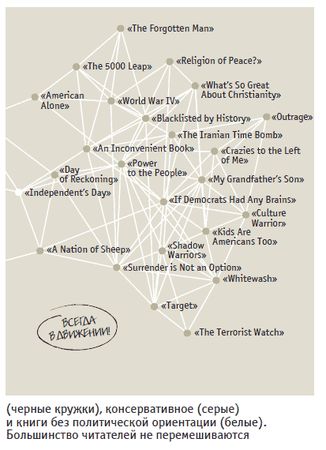
Приложение
Литература
Argyris Chris, Schдon Donald. Organizational Learning. Prentice Hall, 1978.
Becker Udo. Lexikon der Symbole. Herder, 1998.
Beck-Bornholdt Hans-Peter. Der Hund, der Eier legt – Erkennen von Fehlinformationen und Querdenken. Rowohl, 1997.
Benesch Hellmuth. DTV Atlas Philosophie. 2007.
Bourdieu Pierre. Die feinen Unterschiede: Kritik der gesellschaftlichen Urteilskraft. Suhrkamp, 2000.
Elbaek Uffe. Kaospilot A-Z. Fдorlaget, 1997.
Esquire Black Book 2007. Hearst Corp, 2007.
Friebe Holm, Lobo Sascha. Wir nennen es Arbeit. Heyne, 2006.
GDI Impuls. 2005. № 3.
Gladwell Malcolm. The Tipping Point. Black Day Books, 2002.
Horx Matthias. Anleitung zum Zukunfts-Optimismus – Warum die Welt nicht schlechter wird. Campus-Verlag, 2007.
Kelley Tom. The Art of Innovation. Currency, 2000.
Klein Naomi. The Shock Doctrine. Metropolitan Books, 2007.
Koch Richard. The 80/20 Principle. The Secret of Achieving More with Less. Doubleday Business, 1997.
Kreiner Kristian, Christensen Soeren. Projektledelse i loest koblede systemer. Jurist-og Okonomiforbundets Forlag, 2002.
Macrone Michael. Heureka! – Das Archimedische Prinzip und 80 weitere Versuche, die Welt zu erklären. DTV, 2000.
Mankiw Gregory N. Macroeconomics. Worth Publishers, 1997.
Merдo Laszlo. Die Logik der Vernunft, Spieltheorie und Psychologie des Handelns. Rowohlt, 2000.
Reason James // British Medical Journal. 2000.
Rheinberg Falko. Motivation (Grundriss der Psychologie). Kohlhammer-Urban, 2000.
Scherrer Jiri. Ideenbox. Sauerlдander, 2003.
Senge Peter. 5th Discipline. Currency, 2006. [Рус. изд.: Сенге Питер. Пятая дисциплина: искусство и практика самообучающейся организации. М.: ЗАО "Олимп – Бизнес", 2011.]
Stroebe Wolfgang, Hewstone Miles, Stephenson Geoffrey M. Sozialpsychologie – eine Einführung. Springer, 1996.
Taleb Nassim Nicholas. The Black Swan. The Impact of the Highly Improbably. Random House, 2007.
Vester Frederic. Denken, Lernen, Vergessen. DTV, 1978.
Weis Christian. Marketing, Kompendium der praktischen Betriebswirtschaft. Broschur, 2007.
Withmore John. Coaching fдur die Praxis. Heyne, 1997.
Онлайновые источники
www.pubmedcentral.nih.gov/articlerender.fcgi?artid=1117770 (Модель "Швейцарский сыр").
www.12manage.com/methods_bcgmatrix.html (Матрица BCG).
appreciativeinquirry.cwru.edu/ (Модель "Позитивный вопрос").
www.zwickystiftung.ch (Морфологический анализ).
www.billiondollargraphics.com
www.visual-literacy.org/periodic_table.html
www.provenmodels.com
Islandia.law.yale.edu/ayres/predictionTools.html
Источники, использованные при создании иллюстраций
Модель "Швейцарский сыр": Reason James // British Medical Journal, 2000; www.pubmedcentral.nih.gov/articlerender.fcgi?artid=1117770
Модель "Рыночный дефицит": www.innovation-aktuell.de
Диффузионная модель: Gladwell Malcolm. The Tipping Point. Black Day Books, 2002.
Модель "Подарки" от журнала "Esguire": Esquire. 2007. № 15.
Модель Уффе Эльбека: Elbaek Uffe. Kaospilot A-Z. Kaos Communication, 2003.
Модель "Мода": Sommer Eric. Mode, le monde en mouvement. Village Mondial, 2000.
Модель "Мода-2": Esquire. 2007. № 15.
Модель "Поток": Czikzentmihalyi Mihaly. Creativity. Flow and the Psychology of Discovery and Invention. Harper Perennial, 1996.
Модель Sinus-Milieu: www.sinussociovision.de
Модель Бурдье: Bourdieu Pierre. Die feinen Unterschiede: Kritik der gesellschaftlichen Urteilskraft. Suhrkamp, 2000.
Модель "Дилемма заключенного": Merдo Laslo. Die Logik der Vernunft, Spieltheorie und Psychologie des Handelns. Rowohlt, 2000.
Модель нестандартного мышления: Moeller Toke, Nissen Monica // www.interchange.dk
Пирамида Маслоу: Gottlieb Duttweiler Institut.
Модель "Баланс работы и досуга": Atlas Psychologie. dtv, 1997.
Модель "Политический компас": www.politicalcompass.org
Модель Херси – Бланшара: Hersey P., Blanchard K., Johnson D. Management of Organizational Behavior: Leading Human Resources. Pearson Eduction, 2008.
Модель Дрекслера – Сиббета: www.grove.com
Ролевая модель: www.belbin.com
Модель "Последствия": Kreiner Kristian, Christensen Soeren. Projektledelse i loest koblede systemer. Jurist– og Ökonomiforbundets Forlag, 2002.
Модель Уитмора: Withmore John. Coaching für die Praxis. Heyne, 1997.
Модель "Когнитивный диссонанс": Tavris Carlo, Aronson Elliot. Mistakes Were Made (But Not by Me). Harcout, 2007.
Послесловие: www.orgnet.com/divided.html